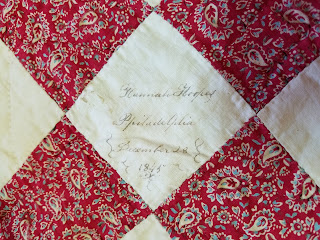During this week of Thanksgiving in the United States of America, we are grateful to the owner of this mid-nineteenth-century quilt, Glorian Sipman, who kindly agreed to share photographs and her research concerning this lovely fifty-block Pennsylvania Friendship Quilt with readers of this blog. An
experienced researcher, Glorian has deciphered the inscriptions on many of the quilt’s
forty-five blocks that have names of men and women, verses,
dates, and locations written in ink.
Pennsylvania Friendship Quilt, dated 1844-1849.
Collection of Glorian Sipman.
Photograph by Emily Musser, courtesy of the owner.
Interestingly, there is only one inscribed date written in the Quaker style: "12 8th 1843." Members of the Religious Society of Friends used numbers instead of, "...the names of days (Sunday to Saturday) and months (January to August) which derived from pagan gods, substituting numbers." (FHL of Swarthmore)
A Quaker-style date is just one clue used to establish a historical quilt's Quaker provenance. Many of the
inscribed surnames are familiar to Quaker researchers, such as, Gillingham, Harlan, Hoopes, Lamborn, etc. Indeed, Glorian Sipman was
able to locate many of the signatories in the records of the Green Street
Monthly Meeting, the New Garden Monthly Meeting and the Philadelphia Monthly
Meeting.
While every quilt block could tell a story, we often look to the center blocks of signature quilts, first, for clues about why they were made. In this case, the center block was dated March 9th, 1844. It was inscribed with the names of Samuel Kinsey (1777-1854) and his wife, Rachel (Eastburn) Kinsey (1787-1867). Some of the other names on the quilt denote their children. Samuel and Rachel were married in 1809 in Bucks County, Pennsylvania. They had seven children. Four of them stayed in Pennsylvania. The other three moved (eventually) to California, New Jersey and Delaware and the youngest Kinsey married a Mennonite.
The inscription on the quilt's center block includes this verse:
View these
few lines
And think of
us
When we are
laid in to the dust
As research progresses, we may be able to connect one of quilt's inscriptions to an event, such as a marriage and/or migration. It is important to note that the quilt may have been made and inscribed by people giving it as a gift to
people who were not actually named on the quilt. This was not uncommon, and it is not impossible to discern a quilt's intended recipient but it does present challenges.
In the meantime, we can enjoy looking at the quilt's leaf motifs, vine border and wonderful mid-nineteenth-century fabrics.
Notes:
All photographs in this post are courtesy of Glorian Sipman. All Rights Reserved. Text © Mary Holton Robare 2019.
Special thanks to Glorian Sipman for sharing this quilt, and thank you to my readers for your continuing interest.
For more about Quaker-style dates see, “The Quaker Calendar” on the Friends Historical Library of Swarthmore website: https://www.swarthmore.edu/friends-historical-library/quaker-calendar. Retrieved 25 November 2019.
For more about Quaker-style dates see, “The Quaker Calendar” on the Friends Historical Library of Swarthmore website: https://www.swarthmore.edu/friends-historical-library/quaker-calendar. Retrieved 25 November 2019.









